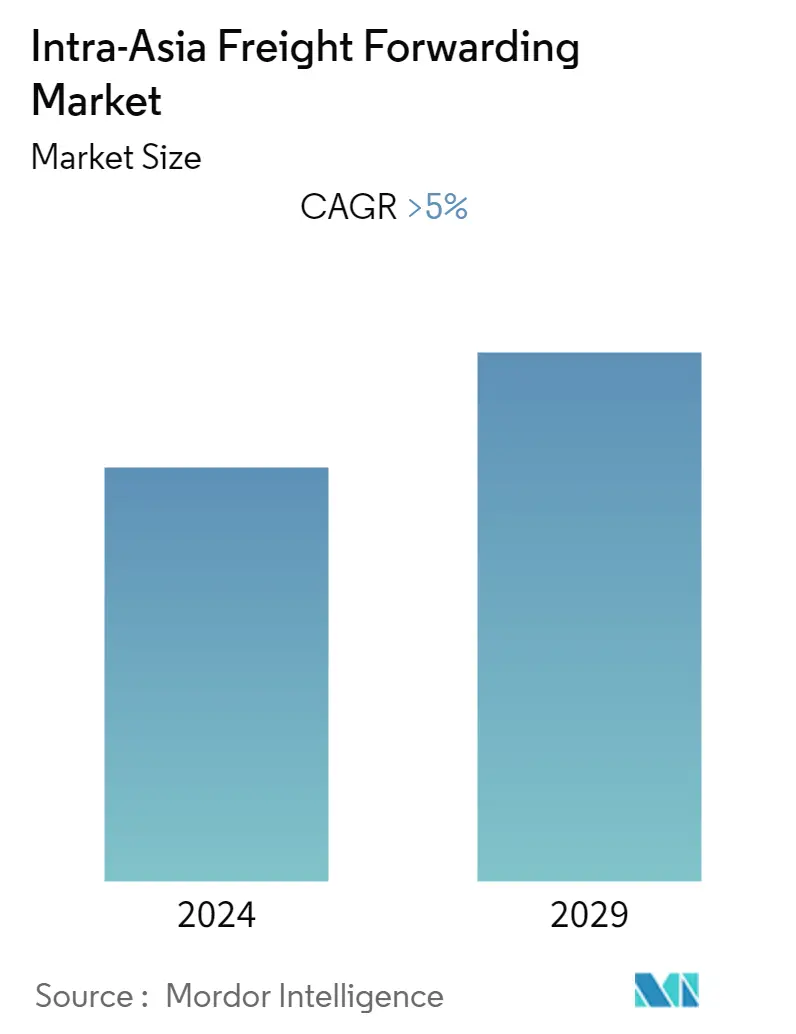Market Size of Intra-Asia Freight Forwarding Industry

| Study Period | 2019 - 2029 |
| Base Year For Estimation | 2023 |
| Forecast Data Period | 2024 - 2029 |
| Historical Data Period | 2019 - 2022 |
| CAGR | 5.00 % |
| Market Concentration | Low |
Major Players
*Disclaimer: Major Players sorted in no particular order |
Intra-Asia Freight Forwarding Market Analysis
Over the next few years, the intra-Asia freight forwarding market is expected to register a CAGR of more than 5%.
- The COVID-19 pandemic led to global lockdowns, and commercial activities were halted, challenging the economy and disrupting the freight forwarding market with massive changes in operations, supply chains, regulations, and workforce requirements. Air and ocean freight volumes fell significantly in 2020; total ocean freight container volumes handled at Chinese ports dropped by 10.1% in the first few months of 2020. Later, as restrictions eased, cargo movement increased significantly across the region.
- Countries are also working on joint projects to boost cross-border trade. For example, in January 2023, the Indian Ministry of Road Transportation and Highways and the Japanese Delegation met to work on projects for digital transformation in the areas of intelligent transportation systems and eco-friendly mobility.The committee also planned to build roads between India and Japan so that people and goods could move more easily.
- In the meantime, Swissport, an aviation company, opened a new air cargo center at Central Japan International Airport in October 2022 to meet the growing demand for freight transport.
- Asia, on the other hand, is becoming a global logistics hub right now, and it is expected that the region will be responsible for about half of the world's trade growth by 2030. Also, more start-ups, mergers, and acquisitions brought more than USD 25 billion to Asia in the first quarter of 2021. So, the region's freight forwarders can expect a lot of business from the growing number of projects and trade activities.
Intra-Asia Freight Forwarding Industry Segmentation
Freight forwarders are an important part of the supply chain. They act as middlemen between the company that ships the goods and the place where the goods will end up.It is the coordination and shipment of goods from one place to another via single or multiple carriers via air, marine, rail, or highway. The report provides a complete background analysis of the global freight forwarding market, which includes an assessment of the economy, a market overview, market size estimations for key segments, emerging trends in the market, market dynamics, and key company profiles. The report also covers the impact of COVID-19 on the market.
The Intra-Asia Freight Forwarding Market is segmented by mode of transport (air freight forwarding, ocean freight forwarding, road freight forwarding, and rail freight forwarding), by customer type (business-to-business (B2B)), by application (industrial and manufacturing, retail, healthcare, oil and gas, food and beverage, and other applications), and by geography (China, Japan, South Korea, India, and the Rest of Asia). The Intra-Asia Freight Forwarding Market report offers market size and forecast values (in USD billion) for all the above segments.
| By Mode of Transportation | |
| Ocean Freight Forwarding | |
| Air Freight Forwarding | |
| Road Freight Forwarding | |
| Rail Freight Forwarding |
| By Customer Type | |
| Business to Business (B2B) | |
| Business to Customer (B2C) |
| By Application | |
| Industrial and Manufacturing | |
| Retail | |
| Healthcare | |
| Oil And Gas | |
| Food And Beverages | |
| Other Applications |
| By Geography | |
| China | |
| Japan | |
| South Korea | |
| India | |
| Rest of Asia |
Intra-Asia Freight Forwarding Market Size Summary
The intra-Asia freight forwarding market is poised for significant growth, driven by the region's emergence as a global logistics hub. The market is experiencing a resurgence following the disruptions caused by the COVID-19 pandemic, which had initially led to a decline in freight volumes due to global lockdowns. As restrictions eased, there was a notable increase in cargo movement, supported by collaborative projects aimed at enhancing cross-border trade, such as those between India and Japan. The region's strategic initiatives, including the establishment of new air cargo centers and advancements in digital transformation, are expected to bolster trade activities. Asia's role in global trade is anticipated to expand, with the region contributing substantially to worldwide trade growth, further fueling the demand for freight forwarding services.
The growth of e-commerce in the Asia Pacific region is a significant factor propelling the intra-Asia freight forwarding market. Rapid urbanization, a burgeoning middle class, and the widespread adoption of digital payments have accelerated the expansion of the e-commerce ecosystem, necessitating robust logistics and supply chain solutions. The region's dominance in retail e-commerce, particularly in China, has led to increased demand for efficient freight forwarding services to support seamless goods movement. Additionally, Japan's thriving freight forwarding sector, driven by increased trade activities and air cargo transportation, underscores the market's potential. The fragmented nature of the market, with a mix of global, regional, and local players, presents opportunities for companies to leverage technology and expand their operations, ensuring they remain competitive in a rapidly evolving landscape.
Intra-Asia Freight Forwarding Market Size - Table of Contents
-
1. MARKET INSIGHTS
-
1.1 Current Market Scenario
-
1.2 Value Chain / Supply Chain Analysis
-
1.3 Insights on Investment Scenarios
-
1.4 Insights on Government Regulations and Initiatives
-
1.5 Brief on Technology Development in Online Freight Forwarding and Digital Platforms
-
1.6 Digitalisation of Freight Forwarding Market
-
1.7 Overview on E-commerce Logistics and Freight Forwarding
-
1.8 Impact of COVID-19 on the Market
-
-
2. MARKET SEGMENTATION
-
2.1 By Mode of Transportation
-
2.1.1 Ocean Freight Forwarding
-
2.1.2 Air Freight Forwarding
-
2.1.3 Road Freight Forwarding
-
2.1.4 Rail Freight Forwarding
-
-
2.2 By Customer Type
-
2.2.1 Business to Business (B2B)
-
2.2.2 Business to Customer (B2C)
-
-
2.3 By Application
-
2.3.1 Industrial and Manufacturing
-
2.3.2 Retail
-
2.3.3 Healthcare
-
2.3.4 Oil And Gas
-
2.3.5 Food And Beverages
-
2.3.6 Other Applications
-
-
2.4 By Geography
-
2.4.1 China
-
2.4.2 Japan
-
2.4.3 South Korea
-
2.4.4 India
-
2.4.5 Rest of Asia
-
-
Intra-Asia Freight Forwarding Market Size FAQs
What is the current Intra-Asia Freight Forwarding Market size?
The Intra-Asia Freight Forwarding Market is projected to register a CAGR of greater than 5% during the forecast period (2024-2029)
Who are the key players in Intra-Asia Freight Forwarding Market?
Maersk, DHL, CHINA COSCO SHIPPING, NYK Line and Asia Forwarding Private Limited. are the major companies operating in the Intra-Asia Freight Forwarding Market.

